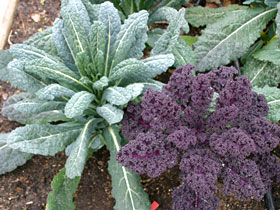Kale

The word "kale" often brings to mind an image of the purple and lime green frilly balls of
ornamental kale in the garden. But culinary kale is a different vegetable entirely. There is an
array of varieties available, from smooth light green to crinkly, almost black to Red Russian that
turns purple-red in cold weather.
About This Plant
Compared to kale purchased in the grocery store, homegrown kale is considerably more tender
and succulent as well as infinitely sweeter. It is also a nutritional powerhouse, loaded with iron,
vitamins A, B and C, not to mention calcium and potassium and cancer-fighting antioxidants.
Easier to grow than many of its cabbage family relatives, cold-hardy kale will continue to
provide a delicious fresh harvest even as the weather cools. In fact, a few frosts will even
improve its flavor.
Site Selection
Select a site with full sun to light shade and well-drained soil. Prepare the garden bed by using
a garden fork or tiller to loosen the soil to a depth of 12 to 15 inches, then mix in a 2- to 4-inch
layer of compost.
Planting Instructions
For a spring crop, start seeds indoors 6-8 weeks before the last expected spring frost; move
hardened off seedlings to the garden 2 weeks before the last frost. Or sow seeds directly in the
garden as soon as the soil can be worked. Start seeds for a fall crop 8 weeks before the first
expected fall frost. In mild winter areas, sow seeds in late fall for a winter and early spring
harvest.
Sow seeds ?- ? inch deep, 4 inches apart in the row. When plants are a couple of inches tall,
thin to a 12-18 inch spacing.
Care
Mulch the soil around your kale plants and be sure to keep it consistently moist. While kale is
less troubled by insects and disease than other members of the cabbage family, floating row
covers will help to exclude pests such as cabbage loopers, cabbageworms and flea beetles.
Contact your local county Extension office for other control methods.
Harvesting
To harvest early, cut individual leaves as soon as they are big enough to eat, about 3 inches
long. Continue picking outer leaves or harvest the entire head when it is about a foot tall. Cool
weather and light frost improves the flavor of kale, so you can harvest over a long time in the
fall. Harvest spring plantings before warm weather toughens the leaves.






 The word "kale" often brings to mind an image of the purple and lime green frilly balls of
ornamental kale in the garden. But culinary kale is a different vegetable entirely. There is an
array of varieties available, from smooth light green to crinkly, almost black to Red Russian that
turns purple-red in cold weather.
The word "kale" often brings to mind an image of the purple and lime green frilly balls of
ornamental kale in the garden. But culinary kale is a different vegetable entirely. There is an
array of varieties available, from smooth light green to crinkly, almost black to Red Russian that
turns purple-red in cold weather.